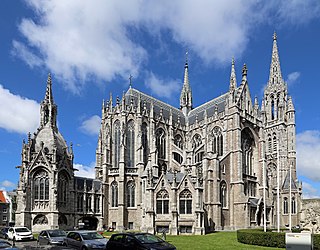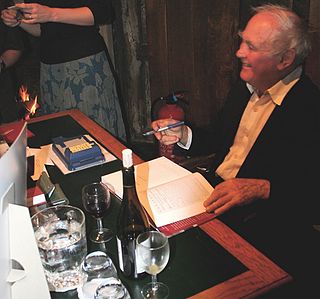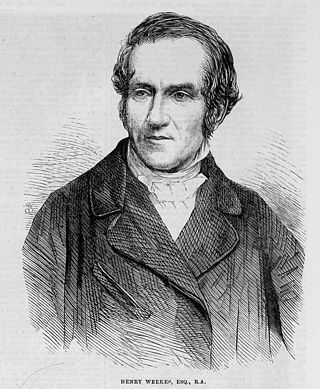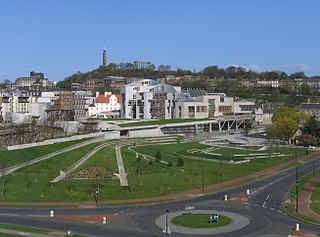Related Research Articles

Robert Adam was a British neoclassical architect, interior designer and furniture designer. He was the son of William Adam (1689–1748), Scotland's foremost architect of the time, and trained under him. With his older brother John, Robert took on the family business, which included lucrative work for the Board of Ordnance, after William's death.

Sir Nikolaus Bernhard Leon Pevsner was a German-British art historian and architectural historian best known for his monumental 46-volume series of county-by-county guides, The Buildings of England (1951–74).

Gothic Revival is an architectural movement that began in the late 1840s in England. The movement gained momentum and expanded in the first half of the 19th century, as increasingly serious and learned admirers of the neo-Gothic styles sought to revive medieval Gothic architecture, intending to complement or even supersede the neoclassical styles prevalent at the time. Gothic Revival draws upon features of medieval examples, including decorative patterns, finials, lancet windows, and hood moulds. By the middle of the 19th century, Gothic Revival had become the preeminent architectural style in the Western world, only to fall out of fashion in the 1880s and early 1890s.

Sir John Soane was an English architect who specialised in the Neo-Classical style. The son of a bricklayer, he rose to the top of his profession, becoming professor of architecture at the Royal Academy and an official architect to the Office of Works. He received a knighthood in 1831.

Palladian architecture is a European architectural style derived from the work of the Venetian architect Andrea Palladio (1508–1580). What is today recognised as Palladian architecture evolved from his concepts of symmetry, perspective and the principles of formal classical architecture from ancient Greek and Roman traditions. In the 17th and 18th centuries, Palladio's interpretation of this classical architecture developed into the style known as Palladianism.

Eileen Gray was an Irish architect and furniture designer who became a pioneer of the Modern Movement in architecture. Over her career, she was associated with many notable European artists of her era, including Kathleen Scott, Adrienne Gorska, Le Corbusier, and Jean Badovici, with whom she was romantically involved. Her most famous work is the house known as E-1027 in Roquebrune-Cap-Martin, France.

Sir William Reid Dick, was a Scottish sculptor known for his innovative stylisation of form in his monument sculptures and simplicity in his portraits. He became an Associate of the Royal Academy in 1921, and a Royal Academician in 1928. Dick served as president of the Royal Society of British Sculptors from 1933 to 1938. He was knighted by King George V in 1935. He was Sculptor in Ordinary for Scotland to King George VI from 1938 to 1952 then held the post under Queen Elizabeth until his death in 1961.
Sir John Newenham Summerson was one of the leading British architectural historians of the 20th century.
Florencecourt is a small village in County Fermanagh, Northern Ireland. In the 2001 Census it had a population of 135 people. It is situated within Fermanagh and Omagh district. Historically the area was called "Mullanashangan".

The National Museum of Scotland in Edinburgh, Scotland, was formed in 2006 with the merger of the new Museum of Scotland, with collections relating to Scottish antiquities, culture and history, and the adjacent Royal Scottish Museum, with international collections covering science and technology, natural history, and world cultures. The two connected buildings stand beside each other on Chambers Street, by the intersection with the George IV Bridge, in central Edinburgh. The museum is part of National Museums Scotland. Admission is free.

John Frederick Harris OBE was an English curator, historian of architecture, gardens and architectural drawings, and the author of more than 25 books and catalogues, and 200 articles. He was a Fellow and Curator Emeritus of the Drawings Collection of the Royal Institute of British Architects, founding Trustee of Save Britain's Heritage and Save Europe's Heritage, and founding member and Honorary Life President of the International Confederation of Architectural Museums.

Henry Weekes was an English sculptor, best known for his portraiture. He was among the most successful British sculptors of the mid-Victorian period.

Harry Stuart Goodhart-Rendel was a British architect, writer and musician.

The architecture of Scotland includes all human building within the modern borders of Scotland, from the Neolithic era to the present day. The earliest surviving houses go back around 9500 years, and the first villages 6000 years: Skara Brae on the Mainland of Orkney being the earliest preserved example in Europe. Crannogs, roundhouses, each built on an artificial island, date from the Bronze Age and stone buildings called Atlantic roundhouses and larger earthwork hill forts from the Iron Age. The arrival of the Romans from about 71 AD led to the creation of forts like that at Trimontium, and a continuous fortification between the Firth of Forth and the Firth of Clyde known as the Antonine Wall, built in the second century AD. Beyond Roman influence, there is evidence of wheelhouses and underground souterrains. After the departure of the Romans there were a series of nucleated hill forts, often utilising major geographical features, as at Dunadd and Dunbarton.
Bridget Cherry OBE, FSA, Hon. FRIBA is a British architectural historian who was series editor of the Pevsner Architectural Guides from 1971 until 2002, and is the author or co-author of several volumes in the series.
Giles Waterfield was a British, McKitterick Prize winning novelist, art historian and curator.

John Arthur Newman was an English architectural historian. He was the author of several of the Pevsner Architectural Guides and was the advisory editor to the series.

Sussan Babaie is an Iranian-born art historian and curator. She is best known for her work on Persian art and Islamic art of the early modern period. She has written extensively on the art and architecture of the Safavid dynasty. Her research takes a multidisciplinary approach and explores topics such as urbanism, empire studies, transcultural visuality and notions of exoticism. In her work as a curator, Babaie has worked on exhibitions at the Sackler Museum of Harvard University (2010), the University of Michigan Museum of Art, and the Smith College Museum of Art (1998).
Charles James Richardson (1806–1871) was an English architect, artist and writer.
George David Smith Henderson is a British art historian, author, and Emeritus Professor of Medieval Art at the University of Cambridge. He is a Fellow of The Society of Antiquaries of London and a member of the Association of Art Historians. He was awarded the Reginald Taylor Prize by the British Archaeological Association in 1962 for his paper "The Sources of the Genesis Cycle at St.-Savin-sur-Gartempe".
References
- 1 2 Official Website [The Royal Institution of Great Britain http://www.rigb.org/contentControl?action=displayContent&id=00000001169 Archived 26 June 2010 at the Wayback Machine ] (Accessed 19 December 2010)
- ↑ "Oxford Slade Professors, 1870–present" (PDF). University of Oxford. 2012. Archived from the original (PDF) on 13 February 2015. Retrieved 27 January 2015.
- ↑ Google Books (Accessed 19 December 2010)